Marcus Richardson's Blog, page 2
May 5, 2017
Freehold Friday: Flashlight review!
Howdy Freeholders!
So I thought I’d do something a little different this time and give y’all a product review. But first, here’s my usual writing update.
It’s been a pretty exciting week. I have not one, not two, but three of the Solar Storm books in the top 15 on Amazon’s science fiction and fantasy short reads category. Keep in mind this is for books that you can read in under two hours, so this is not exactly the arena for mainstream, 300-page books.

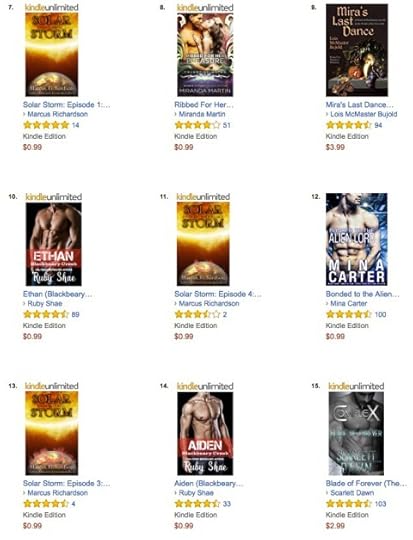
That being said, you can see that I’m in hot competition with J.K. Rowling, which just makes me want to jump and shout. The thing that really gets me though, is the fact that these three books have been in this top 15 group for the past two weeks straight. This is the longest run of my writing career, so I am definitely happy. That said, I couldn’t be in this position without the support of my readers, so a big thank you to all my fans out there!
On top of my excitement over the latest rankings, I am also ready to announce that next Friday I will be publishing the fifth and final episode of Solar Storm Season One. Yes, you read that correctly: Season One.
I have gotten such overwhelmingly positive response for the Solar Storm books, that I have already outlined and launched into writing Season Two! So this is my official renewed for another season announcement LOL. Several people have written to me (thank you, you know who you are!) to express their belief that it’s like reading a TV show!
This made me more happy than I can express, because that is exactly the response I was aiming for! So when you get to the end of Episode 5, don’t worry, Jay and the gang will be back. I’m adding new characters and new points of view—spoiler alert: Mac will get his own storyline by popular demand.
I’m also pleased to announce that next week I will be offering The Wildfire Saga on sale at Amazon, Tuesday through Saturday. You can snag this beast of a book for $.99 (regularly priced $9.99, so don’t miss this deal!). I had such a wild success selling my Future History trilogy, The Collapse Collection for $.99 last month, that I decided to offer all three books (Apache Dawn, The Shift, and Firestorm for $.99 for the first time. So if you’re just joining the Freehold and you’ve only read the Solar Storm books, now is the perfect time to check out Wildfire.
As I said last time, I put the final touches on the first draft of Cooper’s book, Oathkeeper, the first standalone full-length novel in the Wildfire series, and that is deep in the editing process now. I’m also excited to announce that I’ve hired a professional editor to review Oathkeeper, so not only will it be a rip-roaring story, it should also be the most professionally polished story I’ve ever produced to date.
And I’m also three chapters into the first episode of Solar Storm Season Two. I’ve discovered a new outlining method that, if it pans out as well as it has been, I’ll probably end up expanding into a an entire post on its own or at least talking about it on an upcoming podcast.
Speaking of podcasts, I’m still working on material for that, but with the excitement over Solar Storm, I have thrown myself into getting Season Two going. I will continue to update on the podcasts, especially when I’m ready to release them into the wild.
Get on with it already!
Okay, the writing update is over—it was a big one this time, sorry!—now I’m going to do the first in a series of product reviews geared toward the practical prepper. This first one is going to be on flashlights.
I know…flashlights aren’t as sexy as firearms, knives, or all the other cool gadgets and items you can get in your preps, but when the lights go out, when a thunderstorm hits, or when you’re stuck by the side of a road in a car with a flat tire at night, nothing brings more comfort—outside of a firearm, I suppose–then a good, reliable flashlight.
What beats a good, reliable flashlight? A good, reliable, inexpensive flashlight!
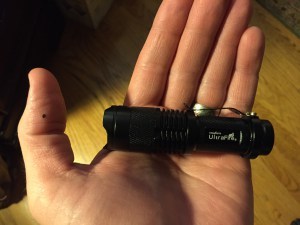 This is what I mean to be talking about today. The UltraFire 7W 200Lumen MiniXPE Q5 Zoomable LED Flashlight (how’s that for a long name?).
This is what I mean to be talking about today. The UltraFire 7W 200Lumen MiniXPE Q5 Zoomable LED Flashlight (how’s that for a long name?).
It has several other names (and I suspect they all come from the same manufacturer) but other flashlights that look similar to this one go from $20-$40 on Amazon. I”m pretty sure this is a quality control reject from the CREE factory, because it says CREE on the side but the logo is crooked. Keep in mind this is a small flashlight, it barely covers the width of my palm, about 4 inches.
That said, finding it on Amazon for $6 with free shipping (if you can stand the 2–3 weeks shipping time) is simply fantastic! Two years ago when I bought my first one, it was only $3. What I do is tack one of these on to an order at Amazon, then I forget about it. When the other stuff I ordered arrives, a few weeks later I get a surprise when a flashlight arrived in my mailbox!
Right, so let’s get into the nitty-gritty on these things. The product page on Amazon claims this flashlight is waterproof. There is an O-ring on the battery compartment lid, but I haven’t dropped it in a glass of water to see if it still works. I have had it out in the rain and snow with no problem. The anti-slip build talked about on the product page is made of several large grooves cut in a nice pattern along the body of the flashlight—I would have to agree, it’ll be damn hard to drop this flashlight. This thing takes one AA battery and it really sips the juice. I did a test and left this thing on for almost 72 hours straight before the battery started to get weak. Now keep in mind these days you can have many different types and strengths of the same size batteries so your mileage may vary when it comes to how long the lights last. I’m usually pretty stingy about battery use, so when I’m done using a flashlight I immediately turn it off. Following that practice, my flashlight has lasted months, not weeks.
So how bright is it? I have to say this sumbitch is extremely bright. One of the questions on Amazon asks how they can make it so bright on one AA battery and the answer is: “The factory employs a Mongolian shaman to bless each flashlight.” I don’t know about all that, but this thing is BRIGHT. It’s got a focusing ring at the front that you can pull forward or pushback depending on what kind of focus you want, too .
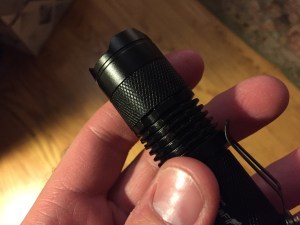
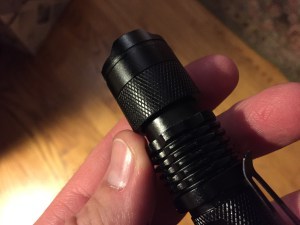
I found when you have it all the way in, creating the widest beam of light possible, it’s pretty damn bright, bright enough to light up an entire room in the dark when pointed at the ceiling.
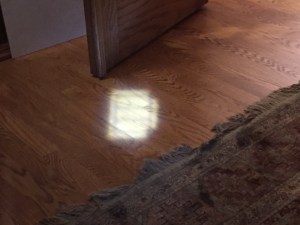
However, this thing really shines when you focus the beam down to the narrowest point. My kids like it, because it looks like the light is putting the image of a fist on the wall.
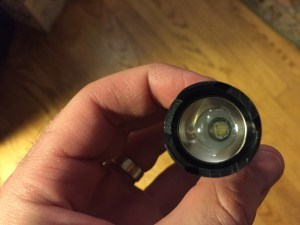 What you’re actually seeing is the LED itself, because the focusing lens on the front reflects inside the housing to create the little diode’s shadow. I don’t quite understand the physics of it myself, but if you turn the flashlight off and stare inside the focusing lens, you’ll see the exact mirror image of what’s displayed on the wall under the high focused beam.
What you’re actually seeing is the LED itself, because the focusing lens on the front reflects inside the housing to create the little diode’s shadow. I don’t quite understand the physics of it myself, but if you turn the flashlight off and stare inside the focusing lens, you’ll see the exact mirror image of what’s displayed on the wall under the high focused beam.
I have tested this sucker out to about 30 yards at night and you can still see that distinct fist shape with the individual bars of light plastered on a tree. In my book, that’s pretty damn impressive. I know I’ve said that before, so hold on, because I’m about to say it again.
The other feature I like is when you depress the power button and hold it for a split second longer than you would if you just clicked it to turn it on, you get a strobe light. The flashlight flashes on and off very rapidly, I guess about six or seven times per second. The cool thing for us as practical prepper’s is this is a self-defense tool.
I guarantee you, if you are in a dark room and you hit the strobe light on this sucker and pointed towards somebody that’s threatening you, they will be blinded if they look at it. As a test, I looked at it myself when I first got it just to see what it was, and I was seeing spots for almost a minute, making it hard for me to move around. And that was in the afternoon, in a room where the curtains had been drawn. At night, when it’s fully dark, the strobe light could be devastating on someone who is attempting to attack you.
As an added benefit, if you’re stranded at night, say on the side of the road, and you turn on the strobe light, I guarantee you oncoming traffic will see you. This thing is bright enough you could probably land a plane in a dark field with it.
Okay, Marcus, it’s got good battery life, really bright, and several nice features. What’s it made of, how heavy is it, and how durable is it?
 It’s made out of aluminum, so it’s very lightweight, but it has a solid heft in the hand when fully loaded with batteries. That means you could have several self-defense uses for this little flashlight. Curl your fingers around it into a fist, and you’ve got essentially a roll of quarters in your
It’s made out of aluminum, so it’s very lightweight, but it has a solid heft in the hand when fully loaded with batteries. That means you could have several self-defense uses for this little flashlight. Curl your fingers around it into a fist, and you’ve got essentially a roll of quarters in your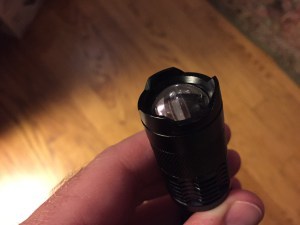 hand.
hand.
Use the tip, which has four squared off edges, for a hammer strike, and now you’ve got an impact weapon that will be guaranteed to leave a mark, not that I’m advocating violence or anything.

It also comes with a handy belt clip not unlike a folding pocket knife.
It weighs 2.29 ounces (from Amazon) and is 3.7″ long and 1.02″ in diameter, so much smaller than a can of soda and easily storable in a pocket, bag, or purse.
As far as durability, I could think of no better way to test this thing to and then to get three of them into the hands of my little Freeholders. They range in ages 8, 6, and 3, so trust me when I tell you that small electronic devices fear them for good reason. We’ve gone through more flashlights than I care to admit, as the kids love “hunting ghosts” at night with them.
Between getting banged around on tables and walls, dropped off of the second floor landing—my house is a veritable graveyard of flashlights. That is, until I handed these babies over. The kids have done their worst and these flashlights have picked up a few dents and scratches, but are none the worse for wear. They still function just as bright and well as they did when I first got them and show no signs of slowing down or damage as far as the light mechanism is concerned.
So for $6 you get one hell of a tool and a nifty flashlight to boot. I have since reclaimed the three test subjects and have positioned them throughout the house in strategic locations. As I get new ones (oh yes, there will be more…I love these flashlights!) I will put them in various get home kits in the vehicles to supplement what I already use.
In short, this little light gets two big thumbs up from the Freeholder!
Keep in mind, I don’t work for the company that makes these things, Amazon, or anyone else for that matter—I don’t get any money if you buy one of these things and I’m not getting paid or reimbursed for my time in writing this review—in any way shape or form. This is just one guy’s review of a flashlight that doesn’t cost over $100 and still gets the job done for preppers.
That’s it for this week, folks. Till next time, keep your heads down and your powder dry.

April 28, 2017
Freehold Friday: Backups. A tale of one Glock, 3 ducks, and Evernote.
Howdy Freeholders!
So I’m sitting here down by river in the mobile office this rainy, cold, windy day, dictating the blog—check out the view from yesterday! (pardon the shaky-ass panorama shot…I’m still getting the hang of it on the iPhone)

Sure beats sitting behind my desk staring at a computer screen. I don’t know what it is about water (especially moving water) that just sets me in a creative mood, but there you go.
So here’s the writing update: This week I’m making strides toward getting my work professionally edited (yes, I have arrived) while at the same time I’m outlining Season 2 of Solar Storm. Y’all have made it abundantly clear by the sales and volume of emails that you want moar, so I shall giveth thou more! In the meantime, Solar Storm 4 is now live! And Solar Storm 5 is currently on preorder, release date set for May 12th.
I also finished the first draft of Cooper’s book, Oathkeeper, this week. It’s headed to the editing phase, hoping to release that soon. I’ve also got an outline ready and even written the first chapter of a book starring everyone’s favorite anti-hero, 13. More on that later though…
Okay. Update complete, here comes the blog (open wide!).
Anyway, I thought today I’d bring you something a little bit different. I’ve got a nice synergy between prepping and writing going on that I just couldn’t pass up. It all stems from my involvement in my local police department’s Citizens Police Academy. Now before you get all excited, no there’s nobody in there making funny noises, and we don’t have anybody like Tackleberry ready to blow things up at a moments notice. It’s a lot more civilized than that. If you don’t know what I’m talking about, just keep reading and forget what you just read.
So let me start by saying that the Citizens Police Academy is probably one of the coolest things I’ve done. It’s a 17 week course and they meet once a week on Wednesday nights for three hours. Normally, I arrive at the police station and we go down to the briefing room and have a lecture from one of the officers or specialists on any range of subjects from evidence collection to forensic science to traffic stops, DUIs and even Mission Teams (drug interdiction, hostage crisis, active shooter, etc.) and SWAT tactics. We also do quite a fair amount of hands-on programs.
Last time, our subject of the day was police firearms training. They brought in examples of the weapons that the officers train on including Glock 21s and AR 15 rifle platforms. We were lectured by several different rangemasters who were also army veterans and got some cool inside information on how the department trains, why they use the weapons they do (here’s a hint: they just work! More on that later) and other anecdotal information that you can’t get from a website. To a writer like me, that is absolute gold.
After the classroom portion of the night, we were taken to the firing range in the police headquarters and used training pistols to shoot some simulated ammunition, they called simunition which is a bullet sized ammo containing a tiny paint ball. It hurts when you’re hit, but obviously not as much as a real bullet and probably not as much as a true paintball (which is much bigger) either. The training guns were exact duplicates of the real thing to make it all as realistic as possible. As luck would have it, I have shot a Glock before, so I knew what to expect, unlike several of the other people in my class.
The rangemaster was telling us how the officers also have high stress simulations they train for, where one officer will dress up in protective gear and pretend to be a belligerent drunk, a angry protester, or perhaps even a burglar trying to break into a building. They have fake doors and whole sets they set up in the firing range, then put officers through their paces, up to and including discharging their weapon (simunition only of course) at the suspect if the suspect is armed and tries to do the same.
I won’t go into the details, one: because it happened so fast, two: because there was a lot of screaming and shouting involved, and my adrenaline was pumping so I wasn’t really sure what else was going on around me. Suffice it to say, it was very intense and I have a newfound respect for anyone who wears the uniform.
When I stepped out into the firing range armed with my simulated pistol I was told the person in front of me was messing with the door to a warehouse in the industrial district at 2 AM and nothing else. So I pretended to get out of my squad car and approached the individual who immediately told me that he was there because he was the owner of the business. Now the good citizen in me wanted to say “Okay, well you have yourself a nice night,” and walk away. But the patrol officer standing behind me quietly whispered in my ear that for safety’s sake, I needed to ask him to keep his hands out of his pockets.
That’s when I realized that I was in way over my head. I’d walked up to a stranger in the dark, by myself (the officer behind me was technically there to tell us what to say if we blanked, because we received no training on this before we were dumped into the simulation) and the guy had his hands in his pockets and talked very fast. Then something clicked—all of my attention focused on him, and I was only vaguely aware of this at the time, but immediately afterwards I realized that I acquired tunnel vision and completely blocked out everything going around me.
I noticed (and wrote down later) all kinds of little details: the way the guy was talking to me was fast and strained, he hunched his shoulders forward like he was ready to run or fight, constantly trying to turn away from me, and keeping his hands in his pockets after I asked him, then commanded him to pull his hands-free—it all set my nerves on edge. Even though I knew we were expected to get into a confrontation—they told us this ahead of time—it was still a heart pounding experience, and I have nothing but respect for the people who do this every day, and not just for pretends. Seriously, cops don’t get enough respect in this country.
At any rate, the suspicious individual had enough of my questioning and spun, pulling his hand from his pocket. I drew my pistol—and I’m proud to say I got mine up faster than him—and started pulling the trigger.
Now here’s where anyone who is way more familiar with guns is going to laugh at me! And I encourage that, just don’t snort your beer just don’t snort your drink through your nose, because that sucks.
In my haste to take down the person who had drawn on me, I started squeezing the trigger before I had a clean sight picture. As a result, my first round popped off and scared the hell out of the floor.
That’s when I would have died.
Despite the fact that all of the officers we talked to confirmed to us that they’ve never had a problem with Glock pistols, the Glock training pistol I shot jammed on the second trigger pull.
Of course this was as soon as my barrel aimed up at the suspect’s chest.
This cause no end of amusement and surprise among the officers, who had just finished giving a lecture on the reliability of not only the standard duty pistols but the training pistols. So there I stood, jammed pistol in my hand as the suspect cracked a smile and pointed his pistol at me.
“BAM, you’re dead!” he said. The suspect/rangemaster then laughed as he pulled off his sweaty face mask and explained, “That’s why you’ve got to keep moving.”
See, never having done this before, when I pulled the trigger I expected it to go bang that second time. When it didn’t, I froze. That gave the suspect enough time to cap my ass. Luckily, in real-life police officers are trained to keep moving and not just stand there like 6’2″ target silhouettes. The other option is to always carry a backup weapon. Just like you see in all those video games, it’s always faster to draw a secondary weapon that it is to reload or fix a jammed primary weapon.
This experience just reinforced my devotion to redundancy and backups in prepping.
Marcus, how the hell does this all tie into writing?
Well, it’s all about the backups. I know you may be thinking: ahh, I know where he’s going with this—something happened and he lost some files on his computer.
No, not quite. Thank God—because my production schedule is pretty hectic and if I lost something right now, I think I’d be reduced to a blubbering, cursing mess. I have a fairly robust backup system (I like to think) for my actual writing.
After I write, Scrivener backs up automatically to Dropbox. When I close out the program, while Dropbox is updating, I take a physical copy of that file that I just closed and copy it to another location on my hard drive. Then every few days, I will take an external hard drive and connect it to my Mac and make a backup of all of my writing.
At the same time, I have another external hard drive (used to be in an old laptop that was too old to run Windows) uses Time Machine to make continuous backups of everything on my computer.
And as for another layer of protection, I have a dedicated NAS cloud server in my house that we use for streaming movies to the different TVs at the Freehold. I also have this set up to copy over Wi-Fi everything on my Mac to the cloud to the private cloud. This I can access from my iPad or my iPhone so I literally have several copies of everything I’m working on.
But that’s not what I’m talking about here. The backup I’m talking about is for Evernote. I don’t know how many of you out there use Evernote, but I use it extensively, almost exclusively—till now.
I have notes that list cool websites with neat articles that I intend to make into stories or use as reference or resources for existing stories, I have story ideas, I have to-do lists, I have just about anything you can think of relating to writing in my notes on Evernote—synced to all my devices and computers. And I also have one master note to rule them all, called the Index. I know, original, right? Here’s what last year’s Index looked like (yeah, I do a new one each year because I also track sales and marketing stuff that I only need the current year for reference)…
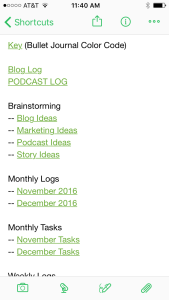
How I use it is I go into my desktop version of Evernote (why they don’t allow you to do this on the mobile versions I don’t know but it drives me nuts!) And take links for all my various notes and put those links on one note. That way when I start up Evernote and I’m trying to find something, I just click on the link from that one main note and I can jump to anything in my notebooks, of which I have dozens. It took me hours and hours to set up, but I use it every single day and it is a huge timesaver! It’s like having a shortcut list for my shortcuts. It was the perfect solution to having a digital notebook and saved me reams of paper and probably several dozen trees.
Until it all went to shit yesterday.
I happen to be waiting for the dog to do her business and clicked on my phone to do my note review. Finding something interesting that I wanted to write about in my story ideas note, I made a point to remind myself to look it up when I got to the basement writing area. After my dog came in, I grabbed my iPad, a bottle of water, and me and Trinny went downstairs to settle in for some writing. I pulled up the Index on my iPad, prepared to get to busy to get down to work, and found that all of the links on my index were gone.
No cause for panic, the data the names and everything were still there, the original notes were still saved, but all of the links had been removed. I was staring at a screen of nothing but text. So, I closed Evernote out, waited for it to sync, then went to my phone. Sure enough, everything worked fine on the phone.
As a test, I went upstairs to the Mac Mini, pulled it up there, and once again everything worked fine. So it looked like it was simply a problem of something not syncing right on the iPad.
Fine. I went back to the iPad and pulled it up again, only this time I was met with an error message saying it could not sync the file. After several minutes of frustratingly useless effort, I contacted Evernote via email. Moving on with my life, I got back to work.
About an hour later, I got an email from Evernote saying hey, “this happens every now and then here’s how you fix the problem: copy the text out of your note, save it, into a different note, then delete the original note and remove it from the trash can. Then sync your device and everything should go back to normal. If it doesn’t, you at least have the text of the note saved in a separate note.”
Still skeptical I decided what the hell, these people are the experts. So I did it. And my stuff was gone forever. I still have that note with the text sitting in my inbox. But it does me no good, because all it is is a list of the titles of the notes that I had linked to. When I sync to the iPad, instead of Evernote taking the notes from my phone and my Mac and syncing them to the iPad, it took the fact that there was no note on the iPad and synced that blank note to the phone and the Mac.
My precious index file was gone for good (cue Gollum).
After swearing a blue streak for a few moments, I realized it was my own fault. I had gotten so comfortable in backing up the backups, that I viewed Evernote as a backup, itself. It is not. As with all things in the cloud and all things that sync to the cloud, affecting one affects them all, despite what some helpful person at customer service says. (Big eye roll)
The other notetaking app that I have is Notability. This one however, automatically creates backups of your notes in PDF format and put those on the cloud. It’s more of a hassle if you need to get something out of that note, because now it’s in PDF format, but by God, PDF a PDF is not going to just vanish on you unless something happens to the damn cloud server itself.
So guess where some of my more important documents are going to be migrated to?
Since Evernote doesn’t have the ability to create automatic backups, and considers syncing to another device back up enough, all my “mission critical” notes and files will now be going into Notability, which offers the same syncing as Evernote across all my devices, with the added benefit of backing up things to the cloud as either plain text or PDF (including my handwritten notes!).
So this is all rather long-winded dissertation on the values of backing up, I hope you gotten a little bit of motivation to take care of your own backups. Because in this digital world we live in, there’s nothing quite so bowel liquefying as staring at a blank screen that once had been filled with all of your precious hard work.
The three mallards crossing my office window look rather cold and miserable in the chilly rain falling on the river and I’d say they’re pretty unimpressed.
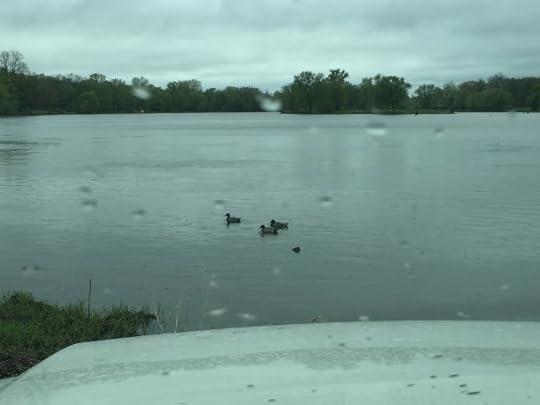
But what the hell does a duck have to back up anyway?
Until next time, Freeholders, keep your guns cleared, your ammo dry, your heads down…and back up your shit. That is all.

April 21, 2017
Freehold Friday: 100th post! And fire pods! Hooray!
Howdy Freeholders!
Welcome to the 100th installment of my blog. Hot damn. I’m back this week with another installment in my practical prepping series. This week, I’ll be walking you through the process of making your own fire starting devices from recyclable materials. Hey, it’s Earth Day this week, right?
But first, I have the writing update: I’ve been busy writing in Cooper’s first book, Oathbreaker and I’m in the last 5 chapters now. Things are really heating up and it’s coming down to the wire for our favorite ex-SEAL. I’ll be starting the editing process soon and look to get the advance copy to my ARC team in the first or second week of May to stay on track for a late May release.
In other news, I’m also working on the Writing Prepper Podcast (woohoo! We have a title now!). I’ve got the first episode in the books but I’m not going to go live until I’ve got at least 3 episodes ready to publish. I’ll be discussing writing, publishing, and prepping on the WPP. So my question for you is what would you like to hear about? What’s your favorite disaster scenario? What do you secretly hope might happen (maybe you want to try out some new preps)? What are you most afraid of? And for the budding authors out there, what do you want to know more about? Marketing? Email lists? Brand building? Last it on me—I’m all ears.
One last thing…y’all see the news about the solar flare? Could this explain the increase in sales for my Solar Storm serial? Hmmmmm…
And now, on with the blog…
Practical Prepping: Fire Starting
Fire! The prepper’s best/worst friend. You need to know how to fight it, survive it, and start it—you do want to stay warm, signal for help, and eat, right?
So how do we start it? Yes, Carl, that’s what matches are for. But what if you don’t have matches? What if it’s raining? What if you only have a few matches or your other method of fire starting has failed? What if you have very little tinder, but plenty of fuel?
Leaving all that aside—think about redundancy. Remember the old saying, “two is one, one is none”? You should always have a primary and secondary means of making fire—whether you’re bugging in or bugging out makes no difference.
In honor of Earth Day, I decided to dedicate this 100th post to the Freeholder Blog to recycling materials found around the house into something you can use to start a fire. I know…it sounds odd to think about celebrating the Earth by starting fire, but focus on the recycling, you pyro.
So what is it that we’re going to create? Candles? Flamethrowers? Torches?
No!
Egg-crate fire pods. These little fire starters are super handy, waterproof, portable, and I’ve clocked them burning anywhere between three and eight minutes, depending on what you stuff them with and how much stuffing you provide. There’s really only a few simple ingredients: a cardboard style egg carton, some dental floss, a bunch of dryer lint, some paraffin wax, and a pot, tin can, or glass jar suitable for melting the wax. That’s really all there is to it!
Once you stuff the egg crate carton pod with dryer lint and wrap it in floss (which I guess is an optional task as you don’t really need the floss, but it makes a handy point for you to use as a fuse) you then drop the completed pod into melted paraffin wax and let it soak. The wax will not only add fuel to the pod, but coat it—once dry, that wax shell will keep it waterproof. Just make sure you give it plenty of time to soak in the paraffin, then dry and cool completely.
To use the pods, I built my fire stack as normal, leaving plenty of space underneath to get things going. With a good air channel, I placed the pod underneath my main fuel, surrounded by tinder. Once the fuse on the pod is lit, sometimes I’ll even light the corner of the pod itself.
Let the fire do its thing. The pod will burn hot and bright at least three minutes—hint: use dryer lint with clothes made of natural fibers for better, longer burn times—and every time I have used them, it’s been more than long enough for the fire to start proper.
So how do we create these wonderful fire starters that use up recyclable materials? It’s super easy.
First, gather your supplies.
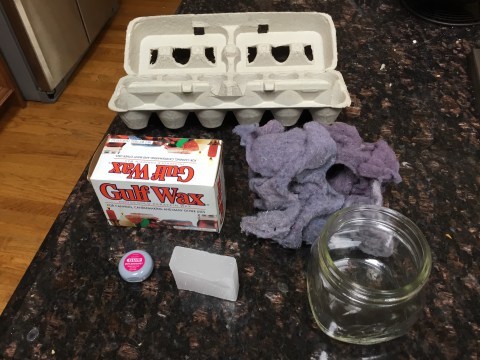
Next, cut the egg carton lid off—if you want, you can cut this into small squares and use these as extra fire starters as well. Depending on the type of egg carton you get, the top may also be shaped into little cups, if that’s the case then you have a double batch! For the rest of us, take the bottom of the egg carton and cut out each individual cup. I used a case from a dozen eggs, so I ended up with a dozen fire starters.
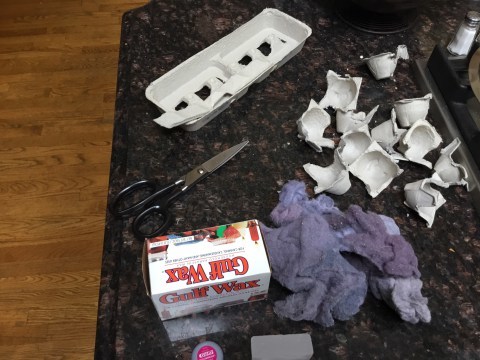
Next, take a good chunk of the dryer lint—hint: don’t grab stuff that’s fresh out of the dryer, make sure you collect it and let it completely, I let mine dry for a day or two—it usually takes me about a week to build up enough lint to create a 12-pack batch of fire pods. Take that lint, stuff it into each pod just enough to fill it, then fold over the corners. It should make a nice neat little package.
Now that you’ve got the basic pod, the next step is to take a length of dental floss—about a foot long—and tie off the pod however you want to keep those flaps under control while leaving a small length of floss hanging free.
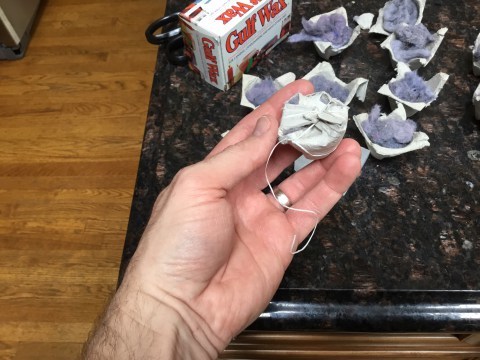
Your nascent fire pod is ready for wax! Normally I would say let’s go on to the wax, however this time I grabbed a floss pack that was already half used—the kids were making leprechaun traps last month—so I ran out of floss with four pods left to go. Did I run and grab another pack of floss?
No!
It’s time to experiment.
With the little floss I had remaining, I wrapped a few of the pods and instead of trying to tie knots—which is the most time-consuming part of this entire process, it took me 15 minutes to do six pods—I used a piece of tape to hold the floss together. My theory is that the wax will end up sealing the pod so well that even if the tape comes apart because it’s dipped in hot wax, the pod won’t fall apart. There’s only one way to find out. With the remaining two pods that did not have floss at all, I simply taped them with scotch tape.
If this works, just taping the pod will shave off at least 75% of the prep time.
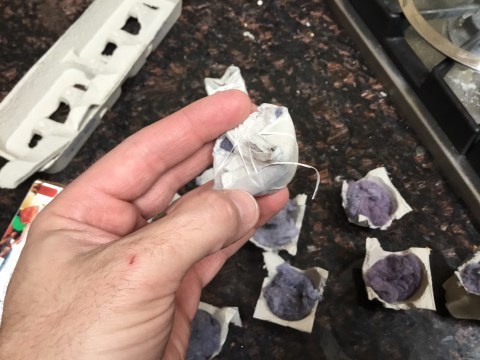
Okay so the next step in the process is to melt the wax. I find the easiest way to do this is using an improvised double boiler on the kitchen stove. I take a small saucepan and fill it about a quarter full of water. You can use either a tin can or a glass jar as the double boiler part. Personally, I prefer glass jar—usually I recycle an empty spaghetti sauce jar. In this case, today I’m using an old mini-Mason jar that has been collecting dust and just been in the way for a while. So I’m going to dedicate this as my new wax melting jar going forward.
Get the water to boil, then reduce to simmer. Place the jar in the water and let it warm up for a little bit. Depending on the size of the jar, pot, and how much water you’re using, this could take anywhere from 30 seconds to a minute or so. Once the jar has been sitting in the water for a while, I break off a chunk of the wax and drop it in.
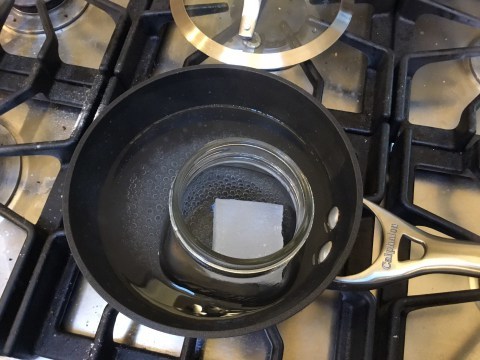
Now that the wax is surrounded by the hot jar, it’ll only take a minute or so, maybe less, depending on how big your wax chunk is and how hot everything is, before the wax block melts and turns into a little puddle of liquid paraffin.
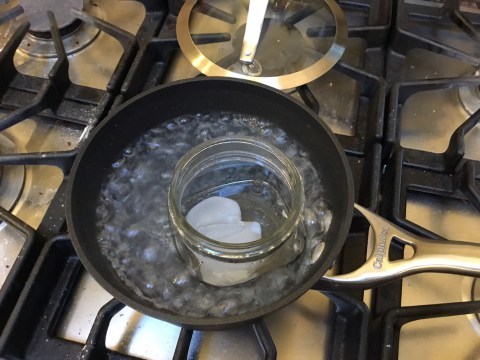
The next step is simply to take your fire pod and drop it in. Take care though, because if this stuff splashes on you, you may get burned—ask me how I know.
Using a pair of tongs or bamboo skewers, or even a fork or something, turn the fire pot over in the paraffin until it’s completely coated, then let it soak for 30 seconds more, absorbing more of the wax and soaking the dryer lint. When you’re satisfied you have let it soak long enough, use those tongs or whatever utensil you’re using to get the fire pod out and set it on something to dry.
I’ve seen people recommend using a baking sheet lined with parchment paper or wax paper, which is probably the best idea because it will allow the fire pod to pop off easy. I’ve done this before with regular plates, and the residual wax is not that big of a deal to scrape off, so don’t think you need to get all fancy here. I don’t happen to have wax paper on hand today, so I’m just going to place them on a parchment paper lined plate.
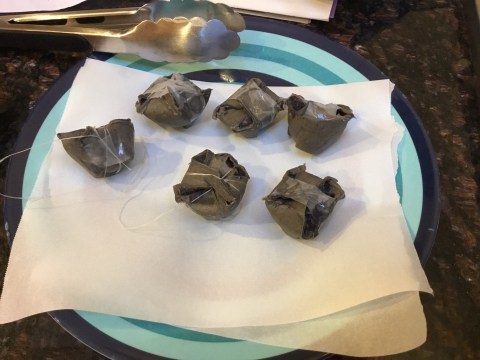
Now that you’ve got one done, the rest of the process is easy–just rinse and repeat until you’re finished.
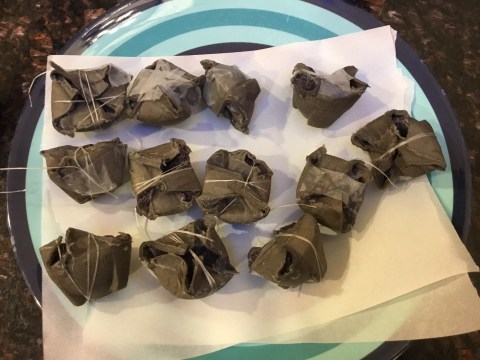
For those of you keeping score at home, I needed about half a box of paraffin wax for my dozen pods. So you can get about 24 pods out of one box, which isn’t very expensive.
When you’re done, just let these puppies dry for a while, I usually leave them alone for the better part of an afternoon and go about my chores or whatever needs to be done around the house, then clean up the kitchen when it’s dinner time.
I store these in a Ziploc bag that I keep with my camping supplies in a closet, but as long as you keep them somewhere away from heat or direct sunlight, these things will last a good long time. They’re waterproof, so they’re great for taking on camping trips in case you get wet.
I haven’t tested them actually starting in a wet environment yet but that’s next on the list. However, because they’re coated in wax, like I said they are waterproof. So I would expect them to do fairly well. You can rely on these having a burn time of at least three minutes, but depending on what type of dryer lint and how much you stuff in each pod, I’ve been able to get almost 8 minutes of burn time on these things.
These are great for keeping in bug-out bags, or in your house emergency supplies for inclement weather, or with your camping supplies. Any way you can have a backup method of starting fire is a plus in my book.
And now for the disclaimer: I post this in the spirit of education and entertainment only. If you choose to do any of the things that I talk, blog, or write about, you do so at your own risk and I assume no liability for your foolishness if you screw something up. You need to do your own research first and think carefully.
A wiser man than me (Robert A. Heinlein) once said “The right to figure things out for yourself is the only true freedom everyone shares. Go use it.”
As with everything in life, make sure you follow any applicable local laws so you stay out of trouble, use caution, have fun, and get prepping!

April 14, 2017
Freehold Friday: Practical Prepping and Water Storage!
Howdy Freeholders!
Lots going on today so I’ll just get right to it.
Writing Update
 Solar Storm Episode 3 is officially live right now (go get your copy!) and Episode 4 is now up for preorder! Release date for Episode 4 will be April 28.
Solar Storm Episode 3 is officially live right now (go get your copy!) and Episode 4 is now up for preorder! Release date for Episode 4 will be April 28.
I want to give a big shout out to the ARC Team—you guys are rocking it! So far my favorite catch (by several people) was when one of my characters referred to assessing the situation as “asses”. That one little word changed the whole meaning of that discussion.
On top of all that, the Future History of America Bundle is on sale for $.99 today at Amazon. Normally it’s priced $9.99 so this is the biggest deal yet! This is your chance to get the whole, massive series in one book for less than a buck!
I’m also plugging away at Oathbreaker, Cooper Braaten’s first solo adventure set in the Wildfire Saga. Look for this one in late May or early June–I’ll be able to pinpoint that date next month.
Okay, enough with the updates—on to the blog!
The Blog
Well…that was dramatic.
This week, I thought I’d take a little look at a topic near and dear to preppers everywhere—water storage. Specifically, how someone on a limited budget can quickly amass a significant amount of safe, potable water, and more importantly, store it long term.
So that’s a pretty good segue into the new segment I’ll do from time to time, which I’m calling…
Practical Prepping
Now if you ask “how do I…?” to 10 preppers, you’ll get 10 different answers, and half of them will be about firearms (that’s just how we do things). Well, here’s my answer, and it’s one I’ve been putting into practice for over a year now.
Full Disclaimer: I’m not one of those guys with enough storage space to hold 50 gallon drums of water stacked on top of each other. (Yet) I’m what’s called a practical prepper. See what I did there? I linked back to the segment…the title…nevermind…just keep reading.
To riddle this out, we’ve got to ask several questions up front:
(1) What situation are you preparing for?
(2) What are your water requirements for that situation?
(3) How long do you want to store this water?
(4) What will you put it in (also affects how long you can store)?
(5) How will you make/keep it potable (keep it sanitized and safe to drink)?
So, let’s look at the first question you should ask yourself: What am I preparing for?
The next power outage? A tornado? A hurricane? Maybe a blizzard or ice storm that knocks out power for a week? A chemical spill on the local train tracks? Maybe a terrorist attack or mass shooting event? Or the end of the world and the dreaded zombie apocalypse? Invading whistlepigs from Mars?
Depending on what you’re prepping for, you’ll need to adjust your storage strategy.
For example, if you’re prepping for a tornado, keep in mind they’re relatively short-lived events. They may knock out power to your town for hours or days—sometimes weeks if you’re dealing with an F5 “Finger of God” monster. Hurricanes, however, will likely knock out power and disrupt critical services to your area or state or region for days, weeks, or even months (see Katrina or Andrew or even Sandy).
So how long term are you wanting to store this hypothetical water? The Federal government suggests enough water for each person in your family for 72 hours, as a general “I’m prepared for the average disaster” guideline. But…well, if you’re reading this you’re already someone who doesn’t necessarily believe the government (remember, these are the same people running your local DMV and the IRS) can and will save you in a time a crisis. Pick any disaster where the government had to step in and save lives on a massive scale—it takes them at least three days just to get the requisite paperwork and “official requests” through the proper channels completed before orders go out to get boots on the ground. Remember, in a state-wide emergency (hurricanes, blizzards, etc.) the state governor must ask for help from the Federal government before anything happens. Only when the governors admit they can’t handle the situation on their own (I’m looking at you Louisiana…Katrina was largely blamed on President Bush, but New Orleans’ Mayor Nagin and Governor Blanco waited far too many precious days before they even asked for Federal assistance,) can the Feds take time to issue orders and gather people to ship to the disaster.
So the Federal government in its infinite wisdom suggests 72 hours worth of food and water. Just out of caution, I’d double that at an absolute minimum. My personal goal is a minimum of 1 week, and then take it from there and see how much water I can pack into my basement without Mrs. Richardson noticing.
Okay…so we each need one gallon of water per person per day. A family of four would therefore need 12 gallons (4 people x 1 gallon each per day x 3 days) of water for 72 hours. This stuff will add up quick, folks.
Luckily, I’ve never personally experienced a power outage longer than a day or so (during a hurricane in Florida, and a freak blizzard in Delaware). In a regional grid down event like Hurricane Katrina in New Orleans, the power was out for much longer than 72 hours. Shoot, I’ve seen reports on the Weather Channel when a severe thunderstorm knocked out power to certain towns and regions for days on end. Even squirrels can cause power outages.
As I stated above, a week (minimum) should be your goal. And like a lot of things in the world of prepping, more is better. Water is what’s called mission critical for life—without it, you’re pretty much toast in a few days. Your aim should be to store as much as possible taking into account physical storage limitations.
So our hypothetical family of four would need at 28 gallons of water (4 people x 1 gallon each per day x 7 days) for one week without power. Side note: this all assumes you live in a place where water is pumped to your house either through the municipality pipes where you live, or through a well pump (both of which require electricity to run unless you have a manual well pump or a solar powered pump). If you live out in an EMP hardened log cabin in the woods and use reindeer to turn a capstan to pull water from an alpine lake, just ignore this post and go buy my books.
So…now we’ve answered what, how long, and how much…next we need to ask:
What the hell do we put all this water in, and how to me make it safe?
I won’t get into the science of what containers are safe for water and what aren’t—do a little Googling of your own and you’ll quickly be inundated with arguments and data. A pretty safe rule of thumb is look at what water and drinks are sold in and reuse those containers—with some caveats.
I’ve seen plenty of advice on the internet about reusing milk jugs to store water. This is a bad idea—the thin plastic milk jugs are biodegradable (there’s a lot of those things in landfills after all) and can (some say will) rupture after 6 months or so if stored in a place warmer than a basement. Ever notice how bottled/jugged water has expiration dates? That’s because by the expiration date, the chemicals in the plastic container itself will leach into the water “affecting the taste”. A good rule to remember is if it affects the taste, it can affect your body—skip those containers for storage and drink the water well before the “expiration” date.
Another way to do this is buy a case of water when it’s on sale. Add it to your stockpile and keep track of it. Well before it’s “expiration” drink that water as you normally would (pack it in lunch, take it to the park, feed it to whistelpigs, whatever) and recycle the bottles, then buy another pack. If you do this and your packaged water is “fresh” and up to date, when disaster strikes you’ll have an additional supply of water on hand that’s convenient for travel (if you have to evacuate on short notice, dragging gallons of water jugs around can get…cumbersome). Plus, when you use that water, you’ll have several extra empty containers to catch rainwater or find other sources of fresh drinking water in a disaster. Bonus!
Okay, back on track. When it comes to plastic food containers, remember plastic by its very nature is porous. Ever put cookies in a ziplock bag and seal it really, really, tight…only to come back a few days later and the cookies are getting stale? That’s because air is passing right through the bag at the molecular level. The same thing works for water bottles. How do we get around this obstacle? Use thicker, non-biodegradable plastic.
Okay, so you’ve done some research, skimmed hundreds of articles online, maybe even read some honest-to-God books and you’re ready to start, you just aren’t sure what to do…so you ask me.
Marcus, what the hell do you use?
I use #7 food safe jugs (turn the container over and look for the little recycle triangle symbol on the bottom)
Pic
…they’re thick and won’t biodegrade. I’ve used some for over a year and have no issues with leakage—I’ve read where people have used these things for multiple years without issue, without problems of taste or chemical leakage.
Great, where do you get them? Well, my favorite source is my local grocery store—or even the gas station or Walmart. See, Arizona Ice Tea in the gallon jugs (along with Arnold Palmer Teas and several other brands) use these thick walled, wide-mouth jugs that are just perfect for water storage.

They’re relatively narrow compared to a milk jug and leave a tidier footprint in my opinion. The brands I use the most are Arizona and Tradewinds. Trader Joe’s also uses the same bottle, I think. Look around and you’ll see what I mean. This plastic is thicker and also slightly cloudy—which is good, because the super clear soda bottles that some people use are only good for a few months (less than milk jugs) because they are so porous. Think about it…you put water in a Dr. Pepper bottle and one month later your water tastes like Dr. Pepper. That means the flavor is leaking out of the plastic (you did clean and disinfect it, right??). If the flavor can leak, you need to plan on the chemicals leaking out too.
Okay…I got my jugs but now how do I take the water from my tap and make it safe to drink 6 months or a year from now?
Back to my iced tea jugs. I buy the tea (catch them on sale with they’re 2-for some dollar amount and save money too), then I drink it and wash out the jug with a little soap and water. Once it’s dry, I’ll fill it with clean water from my tap (which is hooked to a deep well that’s filtered, but this would work for city water too). Now you have a neat and tidy gallon of water—congratulations, you can survive for one day.
To purify this water—whether it’s well or city makes no difference—I add Regular Clorox. Remember to skip the fragrance blends—I don’t know how they make bleach smell like a fresh, windswept sunny meadow, but it can’t be natural…you don’t want that dose of chemical sunshine in your drinking water.
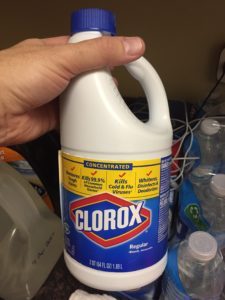
A little of this stuff goes a long way, so please be careful, folks. Use some common sense, okay? I’m not going to be responsible for anyone who pours half a bottle of Clorox into their water supplies. We’re not trying to win Darwin Awards here, people.
From Clorox’s own site, it takes:
Don’t have an eyedropper handy to dole out 6 drops (or 8 if you’re using regular bleach)? My method is to use a drinking straw (my little Freeholders are partial to the bendy ones) and poke a tiny hole in the middle with a thumbtack or kitchen knife. Then I put some bleach in it, bend the ends up to trap the bleach in the elbow (where the hole is) and hover it over the jug of water. If you squeeze it just right (practice over the sink first…it only takes a few times to master this, I promise), you can control the flow of drops that dribble out of that little hole. Six drops of concentrated Clorox takes about 5 seconds to apply so don’t skip this step! Nasty stuff can grow in your water if you just fill it and cap it and store it. You put some Clorox in there and nothing will grow because you’re effectively killing everything in the sealed container.
 That’s it! Cap that jug, shake it up a bit to get the bleach all mixed in, label it with the date you filled the container, and store it. Rinse and repeat with each container you have.
That’s it! Cap that jug, shake it up a bit to get the bleach all mixed in, label it with the date you filled the container, and store it. Rinse and repeat with each container you have.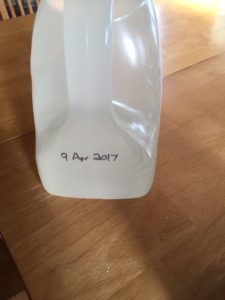
In my case, I buy two at a time, whenever I go to the store or run out of tea…yes, it meant in the beginning I only had a gallon or two of water on hand, but within a few weeks that jumped to about six gallons. After my first month of water storage, I had enough water for my family of 5 to survive that magical federally regulated 72 hour threshold, and I quickly expanded from there. Because…DMV, people. D…M…V.
Okay, so we’ve got the requirements, we’ve got the jugs, we’ve got the water…where do we keep it all?
Remember—plastic is porous, so we don’t want to keep our water anywhere near lots of fumes or chemicals. That means the typical American garage is right out unless you don’t store paint, fertilizer, bug poison, gas, vehicles, or lawnmowers out there (Wow…that makes it seem like every garage is a bomb factory or something). All that nasty stuff puts off trace amounts of chemicals which we’ve already seen can get right into your water supply.
Second, don’t store your plastic water jugs (even if they are the thicker kind) on bare concrete floors (like in the basement for those lucky enough to have one). Concrete these days is made with more than just lime, ash, and water. Over time, trace chemicals can leach up into your containers if they’re just sitting there on the concrete day in and day out for months (or years) at a time. So keep your water jugs away from plastics too—basically anything manmade will contain chemicals that can leach through plastics of all kind given enough time.
The solution? Put wood on the floor, then put your water on that. I’ve seen people use tubafores (2x4s, or Texas toothpicks for those who aren’t woodworkers) spaced out enough to support their water containers and plywood sheets, as well as just about any other type of wood you can think of.
Except one: treated wood. Stay away from treated wood at all costs—sitting the water on the concrete is much better than using treated wood because those things are just saturated with arsenic and all kinds of nasty stuff that will quickly get into your water and contaminate it.
Other than those simple guidelines, you can pretty much be as creative (or not) in your water storage. Do a Google search on water storage and you’ll see what I mean. I’ve seen plywood and tubafore racks, I’ve seen tubafores just laying on the ground, I’ve seen hanging systems, underground cisterns Maud’Dib would be proud of, supplies hidden in coat closets, under furniture…you name it. Water is heavy (8 pounds per gallon) so keep that in mind when designing your storage. You don’t want something collapsing in the middle of the night and wake up to a flooded basement.
One last thing I want to touch on—rotation. Like all our preps (especially food and water) I recommend getting in the habit of rotating your stock. Keep a list or spreadsheet of what you’ve got and where it’s at (you do have an emergency binder for your non-prepping family members to follow should you be away from home when disaster strikes, right? No? Well, fear not, Freeholder, we’ll touch on this in another post).
When the expiration date on an item is approaching (like a month or two away depending on what it is), use that item in your everyday cooking or whatever. Then the next time you’re at the store or preparing preps, replace it and add one more item to the stockpile. That way your supply never goes bad and you also add a little bit each time you remove something.
Your water is no different. It will never expire per se, but some people don’t like the flat taste of water that’s been stored for months or years. To solve this, you could shake up the container and oxygenate it. Or, if there is no crisis and you want to maintain “fresh” water on hand at all times, why not just use what you’ve got by pouring it on the garden, or giving it to your pets, spraying whistlepigs with a Super Soaker, or using it for household cleaning…the possibilities are endless—we use a lot of water each day.
Just remember, replace what you use—immediately.
Then, the next time the power goes out, for any reason, you won’t have to worry about water…at least not right away. You did save enough for more than 72 hours…right? Because those folks at FEMA say 72 is what you need. And if it’s good enough for the government, a kindergartner can find a way to make it better.
Until next time, y’all: keep your heads down and your powder dry, my friends. Now go store some water!

March 31, 2017
Freehold Friday: Solar Storm triple play
Howdy Freeholders!
More excitement today—I’ve got a triple whammy for you. Solar Storm: Episode 1 is FREE on Amazon today. Additionally Episode 2 is now live and Episode 3 is up for preorder!
I want to thank everyone on the ARC Team for taking the time to send me corrections and comments and especially for the fantastic reviews starting to pop up on Amazon already. You guys rock!
Also, I’ve worked the kinks out of my first podcast and I’ll be recording it as soon as I can get the kids out of my office…stay tuned for an announcement about that in the coming days.
In the meantime, I’ll be working on wrapping up Episode 5 and pushing forward with Oathkeeper!
Keep your heads down and your powder dry my friends.

March 24, 2017
Freehold Friday: Solar Storm: Episode 1 is live!
Howdy Freeholders!
Just a quick update today—Solar Storm: Episode 1 is now live on Amazon so y’all can go read it now on Kindle Unlimited!
And, I just uploaded Solar Storm: Episode 2 as a pre-order…it may take a day or so to show up as available to preorder, but at the files are there. I’ll update with a link as soon as it’s ready.
In the meantime, you keep reading and I’ll keep writing!

March 17, 2017
Freehold Friday: Solar Storm: Episode 1 available as preorder!
Howdy Freeholders!
I have exciting news today! I’m pleased to announce the preorder launch of Solar Storm: Episode 1, IMPACT. This is the serialized project I first hinted at in September of last year. The writing is finished and now I’m wrapping up editing. The ARC Team has copies and we are rollin’ folks!
As a special bonus, here’s the cover so you you know what to look for when it goes live on March 24th.
Solar Storm: Episode 1 is live for preorder (it’s a whopping $0.99) and is the first in a 5 part serialized story. Episode 2: NORTHERN LIGHTS will be up for preorder on the day Episode 1 is released (and so on).
So what’s it all about? Well, not to give too much of the story away, this is about an average guy—he’s a librarian for cryin’ out loud—who’s caught up in what happens when a massive coronal mass ejection hits the earth and takes down power grids all over the world. How does he react? What does he do and what does he do it with (he’s not a super-prepper or SEAL, remember, so he’s limited to stuff he has on hand or what other people give him or what he finds/takes, etc.). I see a lot of stories where the main character is a cross between Rambo and MacGuyver with the durability of a Terminator—I may or may not be guilty of creating a character or two like that—but in this story, I wanted Joe Six-Pack to have his say. It was really fun writing it and I hope you’ll have fun reading it. This book is about 80 pages long (so about a quarter my normal size) but it’s only the first episode (of 5). So be prepared, it ends with “To Be Continued…”
But Episode 2 will be coming out March 31st so you won’t have long to fume over the cliffhanger. 
January 27, 2017
Freehold Friday: Firestorm audiobook released
Howdy Freeholders!
Just a quick update today as I have a lot on my plate. I’m very excited to announce that Firestorm (Book III of the Wildfire Saga) is now available as an audiobook! James Romick, who narrated Apache Dawn and The Shift is back for the conclusion of the first Wildfire trilogy. If you haven’t listened to the books before, I highly recommend it—it’s a whole other experience and you don’t have to hold a book or device in your hands!
To coincide with the release of Firestorm in audiobook format, I’m launching my official ARC Team. If you want the details, you need to check your email as I’m sending out a newsletter with all the information you’ll need to get my books free forever. Yeah—every new book! But it’s only for a select few who meet the requirements and volunteer.
What’s that you say? You’re not on my email list? Well, we’ll just have to remedy that, won’t we? To sign up, click here and fill out the form—I promise to only send one or two emails a month. I’ll never sell your info, but you will get a free book and if you choose to join the ARC team you will get free books as long as I’m writing them and you stay in good standing. There’s more but it’s only for people on the mailing list…so what are you waiting for?
That’s it for now, I’m going back to editing CME. In the meantime, as always, keep your heads down and your powder dry, my friends.

January 20, 2017
Freehold Friday: Bureaucracy for Writers
Howdy Freeholders!
This week I thought I’d put together a little post more for the authors out there or prospective authors who might like to read about an experience I’ve had recently—you readers out there may get a chuckle out of this too, so stick around and come follow me down the red-tape rabbit hole.
So what the hell happened?
Well, I’ll tell you (“He’s going to tell…he’s going to tell…” floated through my mind there. If you don’t get that, you need to brush up on your Python my friend). As some of you may know, I recently (well, my family too) moved to a new state.
My wife and I moved the Freehold from the frozen northland of Wisconsin to the not-so frozen, not-quite-as-northland of northern Illinois. I know many of you right now are spitting out your coffee and sputtering “But why???”. Let’s just say that I have good reasons that will benefit my whole family and even you, gentle reader, very soon.
Anyway—we moved. That in and of itself is as most people know, not the most pleasant thing to do, ranking right up there with going to the dentist. Actually, no—I’d rather go to the dentist than move. I’m not talking about getting a new house, learning a new location, discovering all new places to eat and shop, etc.—that’s all the really fun stuff that goes with moving. I mean I’d rather have my teeth drilled then go through all the packing, unpacking, hauling, dealing with rental trucks and movers, paying said movers, the back aches, the head aches, the crying kids, the dusting and cleaning—and let’s not forget the whole mess of selling an old house in the process and all the wonderful little tasks that have to be accomplished along with that!
See where I’m coming from?
Wait—it gets better. Okay, so most, say 90% of the unpleasantness of moving is behind us now. The kids are settled in their new house and school (which is a huge accomplishment) and we’re working on selling the old house. Progress, folks, progress.
The problem? Along with moving my household, I have to move my business (yeah, writing is a business that most readers never see into—I’m about to rectify that, so stay with me now…) south as well. Everything heretofore has been set up in Wisconsin (doing business as The Freeholder Press, my P.O.Box which is used to allow me to send emails to all my followers, tax locations for my distributors, etc.).
Now all that has to come to Illinois. Well fine and dandy. Yesterday, I started working on that. My first order of business (he thought smugly) was to get a new P.O. Box set up so I can transfer my “official address” for The Freeholder Press. This will affect everything from my aforementioned emails to my copyrights from the Library of Congress to my relationship with Amazon.
So, innocently enough, I fill out the paperwork and pay my rental deposit…then get slapped in the face. To get a P.O. Box, I have to show proof of residency—no big deal when I was in Wisconsin, we’d been there for a few years, I had a license, utility bills, a mortgage, you name it.
But here? I got nothing. See, I couldn’t get any utility bills in my name when we moved because as a writer, I’m not considered “employed” by the state of Illinois, or any state really. They say I’m a stay at home dad, so to the government I must sit around eating Doritos and drinking beer all day. I work harder than most road crews I’ve seen thus far (no offense to any readers who are on road crews, but come on…when there’s 10 guys standing around watching 2 guys work, something’s a little off, wouldn’t you say?) but I’m not employed? I’m up all hours of the night dealing with scarlet fever, strep throat, pink eye, diarrhea, nightmares, and tummy aches–I spend the day cleaning and doing dishes and laundry, ferrying kids to and from school, doctor’s offices, dentists, then buy groceries and cook meals, pack lunches…on top of writing, editing, marketing my work and designing cover art and publishing 4 BIG novels a year? And I’m not employed???
Birch, please.
Okay, I sigh, now what do I do?
I need to show proof of residence but I don’t have the required documents (a license plus a mortgage payment or utility bill or something in my name). I have a copy of my house paperwork with my name on it, but still need more.
I scanned down the list of acceptable documentation—license? Nope. Passport—hey I got one of those! Oh, but I still something more. Voter registration? Shoot that’s gotta be easy.
So I mosey on over to the voter registration clinic—I mean website—and sit down on the group W bench and wait my turn. Get this—to register to vote, I need a driver’s license (they won’t for some reason take my valid WI license…) or a SSN. Well, I have that SSN so I fired a nuclear tipped Tomahawk right at the—oh wait, they wanted my Social Security Number.
Great. I filled out the form and mailed it in (yeah, you can’t do it through email without a valid IL driver’s license…). I’ll wait a few weeks to get my voter ID card then proceed to get my P.O. Box—cue screeching brakes.
Hold on there feller, says the government man. We’re not done with you yet.
To get any further in the process I’m going to need that driver’s license. The voter ID is one step in the right direction, along with my passport, my original social security card (thank God I still have it!) a mortgage bill with my current address and my old WI driver’s license.
So, once I get the driver’s license, I should be able to—
Nope.
To get my $%&ing “Doing Business As” registration in line (remember how I moved that stuff from Wisconsin? Well, my county of residence there didn’t require any official paperwork…as long as I said I was The Freeholder Press, I was, according to the state Wisconsin…not here…oooooooh no, no, no. No.) I need an official address.
For security reasons I chose to use a P.O. Box as my “official” address instead of my home address (you fellow authors take not here…this is part of basic security—if you have a stalker or pissed off fan, don’t tell them where you live!).
Hence my quest to find the Holy Grail, I mean P.O. Box. Once victorious on the field of voter registration, I shall take my trophy to the Secretary of State (no, not the ketchup man in Washington) and retrieve my Illinois license. Once I have my license, the bureaucracy will (hopefully) see fit to smile down at me from on high, allowing me the privilege of getting a P.O. Box (at last).
But wait—you ask—why all the rigamarole? Why not just do things like you’ve been doing things? Just slap “Freeholder Press” on the book and wing it! Well, I want to do things the right way. You learn to do that when you work with Amazon (love ya!)—if not, you find yourself writing stories on cardboard boxes in the street. And traffic is not easy to ignore when you’re trying to write. And hey, it’s only $10 for a little peace of mind, so why not?
Well, I’ll tell you why not—just read this post over again—because it’s a huge pain the rear. That’s why. All so I can have some bureaucrat stamp my name in approval and say I’m okay to sell my books in Illinois. As if the people who really matter (Amazon) give a rip where I’m at, as long as they can make money off my work. And that’s the way it should be—I have a relationship with Amazon (nothin’ but love for ya!) and we work well (I think) together. I don’t know the Illinois government (okay…hah, well I know of them but I don’t know them, nowwuddamean?) and…okay, before this turns into Libertarian rant, I’ll just get back to the tale, shall I? I think you get my drift.
Where was I?
Oh yeah…so there I am, gasping, nearly out of strength from clawing my way back up the red-tape rabbit hole. I stagger into the drably appointed office in a drably built government building (that probably cost 4 times what’s worth) and slap down my paperwork in front of a clerk to claim my Doing Business As registration. I did it. I $%&*ing did it! I jumped through all the hoops, filled all the forms in triplicate, got my license, proved I live where I live and I slew the government beast of no-caring.
The clerk smiles, pushes the glasses up his (or her) nose and tells me the form must be notarized. I open my mouth to speak and they slam down a little window that says “On Break—back soon.”
And that’s when the crying starts.
If this tale wasn’t cautionary enough for you, then check out Mike Rowe’s The Way I Heard It podcast from this month, “Oh Brother”. Scroll down to Number 36 (January 12, 2017). I’m serious—it’s only about 10 minutes and it is well worth your time to listen (I could listen to him talk about anything. If he and Morgan Freeman decided to read the phone book I’d listen to the whole thing). In our current national situation, this story he tells is more on target than I thought (the more I think about it). Don’t worry, I’ll have more end of the world stuff next week—and who knows what’s going to happen (or not) at The Donald Show (you gotta admit, whether you like him or not, this country is going for a wild ride). We’ll all have to wait and see.
In the meantime, keep your powder dry, your heads down, and your paperwork properly filed (and notarized!) my friends.

January 13, 2017
Freehold Friday: I’m baaaa-aaaaaack!
Howdy Freeholders!
Man it’s been a while, but I assure you the rumors of my demise were greatly exaggerated. Okay, so no one was really going around saying I was dead or anything. In fact, those readers out there who’ve contacted me privately know I’m not dead—you know what? Nevermind. I’m back.
Why the long absence?
Well, for starters, my family and I moved into a new house in a new state. Moving in general is exciting, but also a lot of work and stress. When you throw into that caring for three little kids and a dog, remove your significant other from the situation (my wife was basically in training out of state in Georgia and Texas and Missouri the whole time with the exception of some time off around Thanksgiving) and things can get a little dicey.
But all that’s behind me now. We’re settled (or settling, there’s still boxes everywhere) into the new Freehold and my office is set up (I have an office!!) and actual windows so I can see outside and be inspired—um, I just saw a coyote take a dump in my backyard. Well…I guess that’s…inspiring.
Other than moving and getting kids over scarlet fever and strep throat (yeah…THAT was fun too) and transferred to new schools, I can honestly say my writing has suffered.
But fear not—I’ve started editing my newest creation, CME, which I talked about last year as being an episodic, serialized story. Well, the first season is written, now I just have to make it readable. That said, I’m free to start outlining my next book, which will be the further adventures of Cooper Braaten (no, that’s not the title)—so all you Wildfire fans out there take heart.
What else? Oh—so hang on to your butts—I’m going to be launching the Freeholder Podcast in the very near future. I’ll discuss prepping, preparedness and writing with a little bit of the apocalypse thrown in for good measure. You won’t want to miss it—yeah you’ll get to hear my voice and probably have a good laugh at my amateurish attempts to join the future (ten years ago blogging was where podcasting is now…I imagine video blogging will be the next thing). Anyway, as launch day gets closer (I still need to get some equipment, but I’ve already got the first episode planned out) I’ll be sure to give you all the details.
And finally I’ll be officially launching the my ARC team. What is an ARC team you ask? Well, I’m glad you asked as I’m going to tell you. ARC stands for Advanced Reader Copy. What this means is an author voluntarily gives a ready-to-publish book away to certain readers who want to help said author by reading the book before it’s released and then leaving a review if they liked it on release day so the book gets a jumpstart in the Amazon charts.
Everyone wins—the reader gets a free copy of the book and the author gets those more precious than gold reviews. For a book just starting out, a decent number of good reviews will make a HUGE impression on new buyers and an even bigger one on Amazon’s algorithms.
There’s a catch though—this requires a commitment. The ARC club won’t be for just anyone. Sure, anyone can get in on the ground floor, but only if you’re signed up for my mailing list. And then, the only way to stay on the ARC team is to prove (send me a picture/screen shot of your review posted on Amazon) you did your part. Those people that do, will get the next book for free. And so on. Oh, and if you drop off at some point you can always get back in, just send proof and you’re back on the team, no hard feelings. That said, because I treat this seriously, I expect ARC team members to be serious about it and people who don’t provide proof are out.
That’s not all—ARC team members, since they will have advanced copies of my books, will have first crack at seeing inaccuracies or anything that needs improving and comment to me about it. That will likely earn you recognition in the book (I’ve seen authors create whole characters based on their own highly contributive ARC team members!) and everlasting fame and glory. All that and you get a free books to read.
Yeah—you heard me right. I’m offering you every one of my future books FOR FREE if you volunteer to do 5 minutes worth of work after you read each one of those books.
Anyway, like the podcast, I’m getting close, but not yet ready to launch all that. I kinda need a new book to have an ARC team and CME is in editing, so…
Okay, so this is turning into one of those “Goals for 2017” things that other people do, but what the hell, tis the season and all that.
What’s after CME and the Cooper book? Well, this year is the year I’m going to diversify. I’ll have details later…like months later…but PA fiction isn’t the only genre I’ve written in. I’ve got some sci-fi and historical fiction books that have been written or mostly written and are just waiting to be edited and released. I’ll use a new pen name so things won’t get too confusing, but needless to say, I have learned an awful lot from my PA fiction that I can’t wait to apply to my sci-fi and historical fiction for a more gritty, realistic read. Those books, since they’re already written, should be able to come out in quick succession, leaving me free to continue writing the stuff that brought you here in the first place.
’Cause everyone loves writing about the end of the world!
Well, maybe I’m just a little twisted, but it is kind of fun to think up new disaster scenarios and plop people in them and see how they get out. Or if they get out. Or if anyone gets out…
If I can get just one person thinking about prepping or personal safety or situational awareness then I’ll be happy. I’m not an EMT or a first responder, so I can’t help out those who do help out when disaster strikes, but maybe if a few people out there think about things differently they won’t need to be rescued…
Ugh, okay, I’m ending this here before we trip into a full on public service announcement.
Keep your heads down and your powder dry, my friends.






